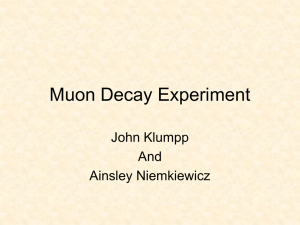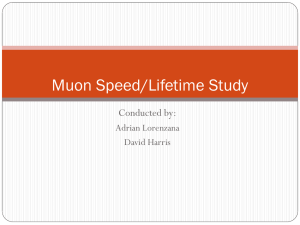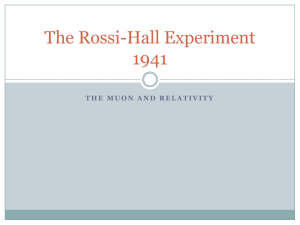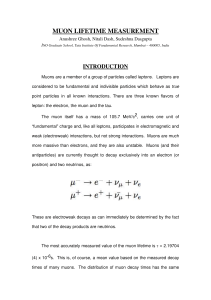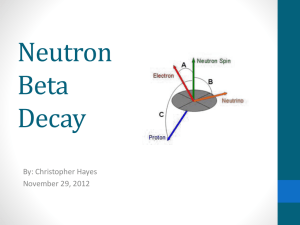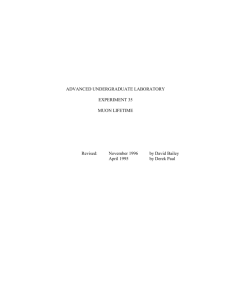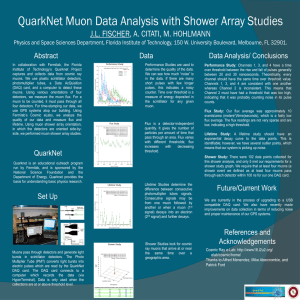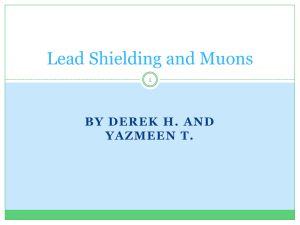Muon lifetime measurement using aluminum as stopping material
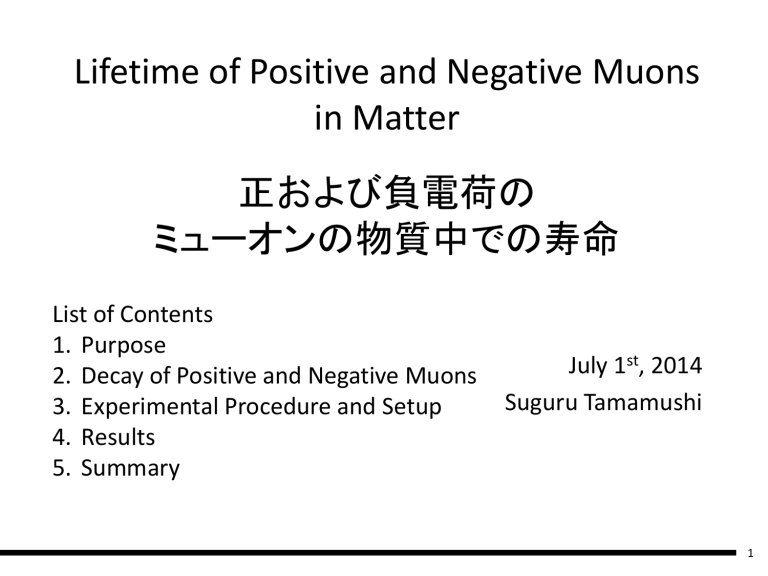
Lifetime of Positive and Negative Muons in Matter
正および負電荷の
ミューオンの物質中での寿命
List of Contents
1. Purpose
2. Decay of Positive and Negative Muons
3. Experimental Procedure and Setup
4. Results
5. Summary
July 1 st , 2014
Suguru Tamamushi
1
1. Purpose
The purpose of this research is:
1.
To understand the basics of plastic scintillators, coincidence, anticoincidence, and accidental coincidence using cosmic ray muons.
2.
To test whether decays of positive and negative muons in materials can be observed.
• Cosmic rays include both positive and negative muons.
The ratio of positive to negative muons in cosmic rays is 1.3 : 1 around 1 GeV/c.
• Cosmic ray muons are stopped in materials.
• Muons stopped in materials have different lifetimes.
Material
Free Decay in C
In Al
In Fe
Lifetime of μ +
(μs) Lifetime of μ −
(μs)
2.2
2.2
2.2
2.2
2.2
2.0
0.88
0.20
2
2. Decay of Positive and Negative Muons
2.1 Decay of Positive Muons
• Positive muons decay as follows:
μ + → e + + ν e
+ ν
μ
• The positive muon lifetime is 2.2 μs
• The number of remaining muons 𝑁 𝜇 as a function of time is:
𝑁 𝜇 𝑡 = 𝑁
0 exp − 𝜏
𝑁
0
: initial number of muons, 𝜏 : muon lifetime.
• The lifetime is determined by measuring the time derivative of the number of decay muons 𝑁 𝑑𝑒𝑐𝑎𝑦
, as a function of time.
𝑁 𝑑𝑒𝑐𝑎𝑦
= 𝑁
0
− 𝑁 𝜇 𝑡 𝑑 𝑑𝑡
𝑁 𝑑𝑒𝑐𝑎𝑦
= 𝑑 𝑑𝑡
𝑁
0
− 𝑁 𝜇 𝑡 =
𝑁
0 𝜏 𝑡 exp − 𝜏
3
2.2 Decay of Negative Muons
• The lifetime of negative muons in matter is different from the lifetime of negative muons in vacuum.
The reason for the difference is the formation of muonic atoms and subsequent nuclear capture.
In muonic atoms, an electron is replaced by a negative muon.
e nucleus
µ -
µ -
• The negative muon follows one of the two competing processes:
1. Decay: μ − → e −
2. Nuclear Capture:
ν e
μ −
+ ν
μ
+ "p" → ν
μ
+ n , or μ
−
+ A → A
∗
+ ν
μ p + n + ….
4
• The lifetime of negative muons ( 𝜏 𝑡𝑜𝑡𝑎𝑙
) in a muonic atom determined by the lifetime of the two competing processes,
Decay ( 𝜏 𝑑𝑒𝑐𝑎𝑦
) and Nuclear Capture ( 𝜏 𝑐𝑎𝑝𝑡𝑢𝑟𝑒
).
1 𝜏 𝑡𝑜𝑡𝑎𝑙
=
1 𝜏 𝑑𝑒𝑐𝑎𝑦
1
+ 𝜏 𝑐𝑎𝑝𝑡𝑢𝑟𝑒
Decay Width Γ = ,
Γ 𝑡𝑜𝑡𝑎𝑙
= Γ 𝑑𝑒𝑐𝑎𝑦
+ Γ 𝑐𝑎𝑝𝑡𝑢𝑟𝑒
• Always
If e − 𝜏 𝑡𝑜𝑡𝑎𝑙 from μ − is measured in experiments:
Decay is detected, 𝜏 𝑡𝑜𝑡𝑎𝑙 is measured.
If proton or neutron from Nuclear
Capture is detected, 𝜏 𝑡𝑜𝑡𝑎𝑙 is measured.
2,5
2
1,5 decay capture
• Capture rate depends on the atomic number Z.
As a result, total lifetime of negative muons 𝜏 𝑡𝑜𝑡𝑎𝑙 depends on Z
1
0,5
0
0 20 40 60 80
Atomic Number Z
100
5
3. Experimental Procedure and Setup
3.1 Experimental Procedure
The time difference (0 ~ 20 μs ) between incoming muon and decay electron or positron is measured. It is recorded to create a time spectrum.
1.
A cosmic ray muon is detected by the top plastic scintillators. This is
START time of measurement.
2.
The muon stops in the material and decays into an electron or positron
3.
The emitted electron or positron is detected by the plastic scintillators.
This is the STOP time of measurement.
µ e -
µ -
Plastic Scintillator(s)
Aluminum, Iron or Plastic
Plastic Scintillator(s) e -
6
3.2 Experimental Setup
#1 Plastic Scintillator e -
PMT
#2 Plastic Scintillator PMT
#3
Plastic Scintillator PMT
Previous Setup
• Only plastic scintillators were used to stop muons
• START: #1 ∩ #2 ∩ #3
• STOP: #2
#1 e
Plastic Scintillator
#2 Plastic Scintillator
-
PMT
PMT
Aluminum,
Iron, or Plastic
#3
#4
Plastic Scintillator
Plastic Scintillator
PMT
PMT
My Setup
• Material to stop muon such as aluminum, iron, or plastic can be replaced easily
• Coincidence is used to detect electrons
• START: #1 ∩ #2 ∩ #3
• STOP: #1 ∩ #2 ∩ #3 ∩ #4 ∪
#3 ∩ #4 ∩ #1 ∩ #2
7
4. Results
1.
The reduction of background using coincidence
2.
Positive muon lifetime
3.
Test of whether the effects of nuclear capture of µ can be seen in aluminum
4.1 Reduction of Background Using Coincidence
• The total count is
3709
• The total count from
10 to 20 μs is only 50.
• The accidental coincidence between
START and STOP signals are substantially reduced.
• Here, a histogram from 0 to 20 μs is shown.
For the rest of this report, I will show histograms from 0 to 10 μs 8
4.2 Positive Muon Lifetime
• Positive muon lifetime was measured using iron.
• Negative muon lifetime in iron is known to be 0.20 μs.
• So the positive muon lifetime can be measured after 1 μs.
• The data with iron was fitted from 1 to
10 μs to eliminate the effect of negative muons.
• The positive muon lifetime was measured to be 2.1 ± 0.15 μs.
2,5
2,4
2,3
2,2
2,1
2
1,9
1,8
1,7
0
2,039
2,097
0,5
Iron 0 microsec
1 1,5 iron 1 microsec
For comparison:
Fit: 1 – 10 μs
Fit: 0 – 10 μs
2
9
4.3 Test of whether the effects of negative muon decay can be seen in aluminum
• Negative muons and positive muons decay independently.
Therefore the fitted function is: 𝑝0 𝑝1 exp − 𝑝1 + 𝑝2
2.2
exp −
2.2
Decay of negative muon
Decay of positive muon
+ 𝑏𝑎𝑐𝑘𝑔𝑟𝑜𝑢𝑛𝑑
• µ lifetime is extracted to be
0.80 ± 0.11 μs
• µ lifetime in aluminum is expected to be 0.88 μs
• My results agree well with earlier value
• The discrepancy at 0 - 2 μs suggests the effect of nuclear capture of negative muons.
• This is a hint of shorter lifetime but further measurement is needed.
10
• I also tested using positive muon lifetimes of 2.1 and 2.0 μs.
In case of 2.1 μs:
In case of 2.0 μs: 𝑝0 𝑝1 exp − 𝑝1 +
Decay of negative muon 𝑝2
2.1
exp −
2.1
Decay of positive muon
+ 𝑏𝑎𝑐𝑘𝑔𝑟𝑜𝑢𝑛𝑑
• µ lifetime is extracted to be
0.93 ± 0.13 μs
11
In case of 2.0 μs: 𝑝0 𝑝1 exp − 𝑝1 +
Decay of negative muon 𝑝2
2.0
exp −
2.0
Decay of positive muon
+ 𝑏𝑎𝑐𝑘𝑔𝑟𝑜𝑢𝑛𝑑
• µ lifetime is extracted to be
0.62 ± 0.28 μs
• These results agree with earlier data.
• The discrepancy at 0 - 2 μs is smaller but still can be observed even if I use 2.1 or
2.0 μs.
12
5. Summary
• The purpose of this experiment is
1. To understand the basics of plastic scintillators, coincidence, anticoincidence, and accidental coincidence using cosmic ray muons.
2. To test whether the decays of positive and negative muons in material can be detected.
• Positive muons decay into positrons.
• Negative muons form muonic atoms in matter and decay or are captured by nucleus.
• Therefore, the negative muon lifetime is shorter.
• In this research, the lifetime of muons in aluminum and iron were measured.
• The background was substantially reduced using coincidence.
• The lifetime of positive muons was measured with iron fitted from
1 to 10 μs.
• I tested whether the effects of negative muon decay can be observed.
• There is a hint of shorter lifetime of negative muons but further measurement is needed.
13
Backup Slides
14
Appendix A: Negative Muon Lifetimes
Material
Ca
Fe
Ag
Pb
H
C
O
Al
Atomic
Number Z
1
6
8
13
20
26
47
82
Negative
Muon
Lifetime (μs)
2.194903
2.020
1.640
0.880
0.333
0.201
0.085
0.082
Error (μs)
0.000066
0.020
0.030
0.010
0.007
0.004
0.003
0.005
Total Nuclear Capture Rates for Negative Muon, T. Suzuki et al.,
Physical Review C, (1987)
15
Appendix B: Background Reduction
Previous Setup My Setup
65000 sec
Average Background: 2.7 count/bin
Total Count: 313
Counts from 10 to 20 μs: 70
130000 sec
Average Background: 0.0 count/bin
Total Count: 194
Counts from 10 to 20 μs: 0
The background was substantially reduced using coincidence.
16
Appendix C: Ratio of negative and positive muons
• The time spectrum was taken for
2,672,167 sec ≅ 742 hr ≅ 31 days
• The ratio of positive to negative muons is extracted to be approximately 6.2: 1
17
Appendix D: Observation of Negative
Muon Lifetime
• The time spectrum data of muon decay in aluminum is divided by the function for positive muon decay.
𝑁
+ 𝜏
+
𝑁 𝜏
+
+ exp − 𝜏
+ exp − 𝑡 𝜏
+
× 1 +
+
𝑁
−
𝑁 𝜏
−
− 𝜏
− exp − 𝜏 exp − 𝑡 𝜏
−
−
𝑁
+ 𝜏
+ exp − 𝑡 𝜏
+
Divided by positive muon decay,
= 1 +
𝑁
− 𝜏
+ exp −𝑡
𝑁
+ 𝜏
−
1 𝜏
−
−
1 𝜏
+ is obtained.
18
